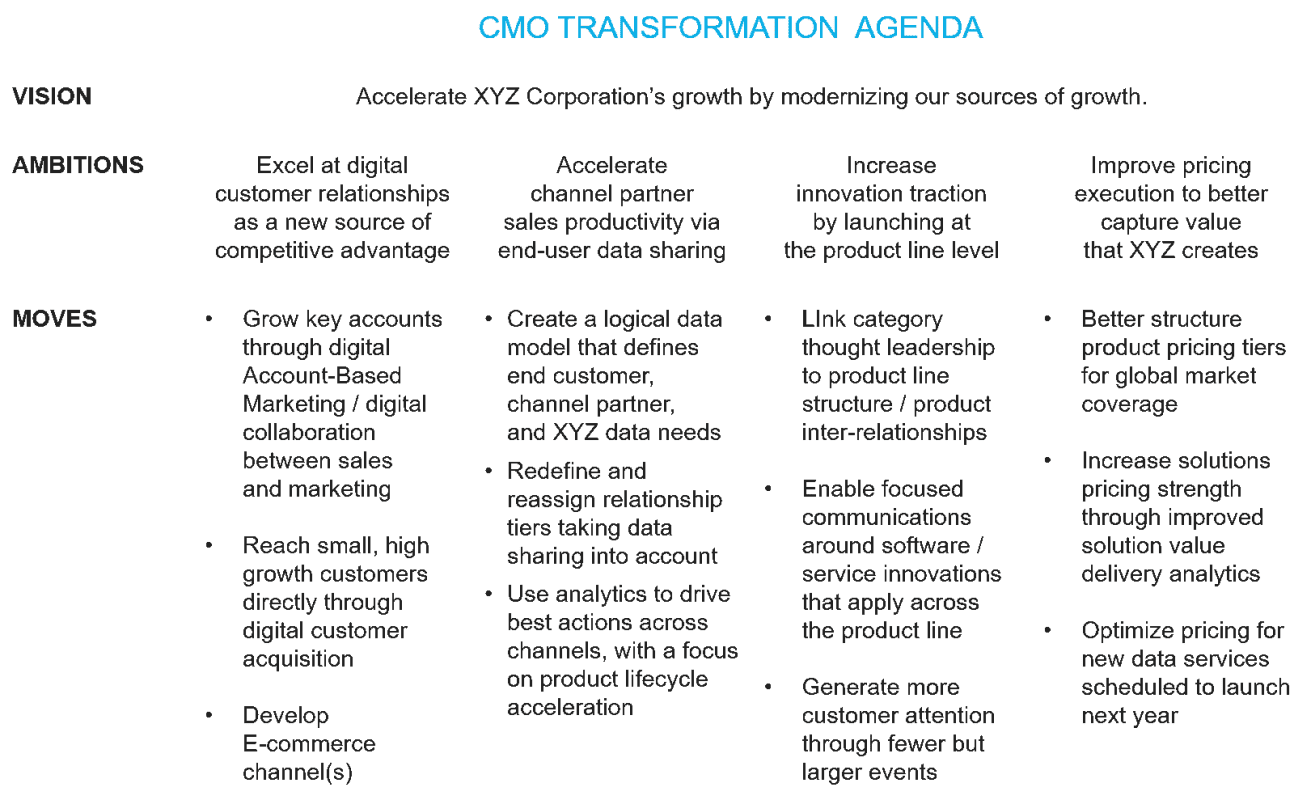BLOG
Now’s the Time to Create Your CMO Transformation Agenda
Marketing leaders need clear ambitions for change–and concrete moves for each ambition.
Victim or Victor?
That’s a choice all CMOs face today in responding to the multitude of changes rocking the marketing landscape. If CMOs let change put them on the defensive, marketing’s role at their companies (and their job tenure) may shrink. But if they get in front of change, the role that marketing plays at the company can become more strategic than ever, with the CMO’s role on the c-suite team more critical.
The average CMO tenure remains short, just 44 months. In many cases careers are brief because CMOs struggle to master a confluence of changes:
- The businesses that marketing supports are changing,
including key aspects of their go to market / commercialization - The behavior of customers served by those businesses is changing
- The way marketing gets done is changing
- The role that marketing needs to play in the company is changing
- The talent that marketing must inspire to join and stay with the company is changing
This presents CMO’s with a pivotal question, every Monday morning. Is that marketing leadership hill that I’m climbing a mountain that I’m going to stand atop? Or is it a volcano that’s going to erupt?
The answer depends in large part on the existence and quality of the CMO’s transformation agenda. It also depends on CMO success in linking their marketing transformation agenda to the company’s overall transformation plan.
“Once developed, refined and socialized, the agenda serves as a guiding light that CMOs use to inspire their workforce and company leadership to invest in new impact.”
Creating a CMO Transformation Agenda
What is a CMO transformation agenda? Very simply, it’s a CMO’s game plan for how a marketing organization undergoing transformation can better serve a company that’s undergoing transformation. Every good agenda includes three elements:
- Clear ambitions for change
- Concrete moves per ambition in a roadmap
- A headline theme that captures the agenda’s overall impact.
Once developed, refined and socialized, the agenda serves as a guiding light that CMOs use to inspire their workforce and company leadership to invest in new impact. Five steps will help CMO’s to effectively develop their agenda.
1. Gather a brain trust who will walk through the agenda development journey together.
The marketing transformation leadership team should be large enough to look at the business and its marketing function from multiple angles, but small enough to keep discussions confidential and minimize politics so that free-thinking ideas can be generated. A team that can be counted on one hand is optimal.
If resources are available, it helps to supplement the effort with an outside advisor in touch with marketing transformation trends across multiple industries to stimulate creative thinking. A good advisor will also provide a helpful sounding board and help synthesize team inputs and outputs into effective communication documents.
2. Prepare the team with common inputs to enable everyone to brainstorm effectively.
The agenda needs to address the underlying forces that are compelling marketing to undergo a transformation. A CMO and team should identify those forces to craft a vision that is on-target for impact.
Start by studying the company’s current corporate strategy and business plans, and compare them to their 3-5-year-old versions. How are the roles of marketing and go-to-market channels changing? Is there leadership talk today of even more change over the horizon? If so what are the implications? Repeat this thought process BU by BU, region-by-region, customer type by customer type, always looking for major patterns (vs. niche instances) of how marketing needs to show up differently.
Key questions to answer in this exercise include:
- How are customer behaviors, priorities, and segments changing?
- How are business models and offer value propositions changing?
- How are routes to market and post-purchase relationship opportunities changing?
Keep bringing these questions back to the implications for marketing:
- What new market-facing capabilities does the business need?
- Which of those capabilities might marketing provide, including new roles?
- How will marketing need to redefine and shift emphasis from its current capabilities?
Beyond taking inspiration from the company’s business requirements, explore changes occurring in the world of marketing, not only in your industry but in other industries that may prove insightful. This exploration will help identify opportunities for marketing to add value in ways that company strategists and peer executives don’t yet know about.
What are key trends in marketing? Our next blog post is devoted to that topic – we’ll share a handful of marketing trend themes that we’ve observed, each one in its own right a combination of 3 to 4 trends.
As you review external marketing trends, ask yourself:
- Which trends obviously apply to our situation? Why?
- What factors underly other trends? Might those factors apply to our situation?
- Do some trends link to our corporate strategy choices? What are dependencies?
- Will key trends be easily understood and received by the company’s leadership team? If not, how much socialization is involved?
3. Over the course of several meetings, brainstorm 3 to 5 transformational ambitions, several moves per ambition, and a unifying vision.
We find the brainstorming process is best served by starting first with ambitions, then moves, and finally vision. That’s because most teams don’t have a clear vision in mind when the process starts. The vision will be more powerful as a “golden thread” expression of what the ambitions have in common rather than a “beacon” that serves as a guiding light throughout for the ambitions.
What does a CMO transformation/change agenda look like? Here’s a hypothetical example inspired by several CMOs who have gone through this process:

Note that the vision statement addresses the “why”, the ambition statements address the “what” and the move statements address the “how.” It’s at the move level that a management team can sequence investment, focus management attention, and harness organizational energy to bring ambitions and vision to life over time.
4. Socialize the Agenda with senior management, the board, and marketing leadership.
When a strong draft of the transformation agenda exists, socialize it with the CEO and other key executives in private. Once their feedback has been incorporated, it’s time to socialize the agenda with the senior management team together.
If possible, strengthen support by presenting an up-leveled version of the agenda to the company’s board of directors. If the CEO arranges for such a presentation, it’s a good sign that the CEO views the CMO’s agenda as a core part of corporate transformation.
After getting buy-in from company leadership, share the plan with the extended marketing leadership team. More times than not, transformation agendas will involve top-down shifts that can be unsettling – a shift in resourcing, a change in skillsets, a re-organization – so become a relentless source of inspiration and encouragement around the agenda to top marketing talent. With leadership, a transformation agenda can mobilize and unite that talent.
5. Build the Foundation for Successful Implementation.
Execution of the change agenda will take several years (vs. months). The team will go farther faster if the CMO builds a strong foundation for change prior to implementing. Depending on the situation this might include steps such as:
- Re-organize to enable new competencies to emerge
- Shift resourcing levels from legacy capability teams to future-focused teams
- Promote new cultural values for new capabilities
- Request extra investments to make needed transitions
- Nurture peer relationships to expand marketing’s role in the company –
often in white spaces involving data, digital monetization, and/or digital CX - Institute agile change processes and pilots to make change happen quickly
- Design enterprise-level programs that change the company, not just marketing
- Find a way to measure and monitor impact with a keen eye on ROI
Common Ambitions in CMO Agendas
Every CMO transformation agenda we’ve seen has a few key elements in common. The most frequent ambitions that we have seen adopted include:
Digital marketing excellence:
Digital marketing is the greatest zone of disruption and innovation in marketing. Unsurprisingly, digital marketing excellence is the most frequently mentioned transformation ambition. Goals might include expanding the number of business use cases that digital marketing empowers (e.g. adding cross-sell and up-sell marketing to new customer acquisition), improving specific capabilities (e.g. real-time personalization) or marketing through new engagement channels (e.g. a conversational commerce platform). Identifying key initiatives on each of these three dimensions is the first step for driving digital marketing transformation.
Data responsibilities:
Thanks to digital touchpoints, customers generate exponentially more data than they ever have before. Data about location, segmentation, digital journey stage, browsing behavior, preference indicators, physical factors, distribution channels, and purchase triggers are all critical for companies to use in their best-move rules. Yet most companies still struggle with capturing, storing, and acting on this data. Will the CMO Transformation Agenda convincingly offer to step up and take responsibility for 360° customer journey data? If not, new executive roles such as chief digital officer or chief customer officer will emerge, narrowing marketing’s role.
New monetization:
Digital enables marketing to create or enhance 1:1 relationships with customers in a way that used to be the sole domain of the sales force or channel partners. Thanks to new digital relationships, marketing can extend its role to help drive growth through monetization techniques never used at scale before. This use of marketing’s competencies for new growth can take several forms:
- Direct sales to fragmented, long-tail end users (e-commerce, AI advisory, etc.)
- Direct management of small channel partners (vs. multi-tiered distribution)
- Next-best-move support to account leaders, sales reps and customer service reps
Varying Ambitions in CMO Agendas
Despite the common patterns above, every CMO’s agenda is unique, reflecting the fact that no two companies and marketing departments are alike. There are dozens of potential ambitions to adopt – here are 20 to help jumpstart your reflection.
- Category Reframing: redefining the company’s value context, proposition and edge
- Launch Re-invention: from launching single products to holistic product line updates
- Influence Scaling: developing a systematic influencer cascade
- Pricing Sophistication: dynamic pricing systems and new value capture approaches
- Solutions Innovation: customer-focused design and partner ecosystem enablement
- AI Integration: enriching marketing and CX through AI / machine learning use cases
- Intelligence Branding: updating Brand Portfolio and Architecture for intelligence
- Re-segmentation: blending best of online and offline information insight sources
- Content Re-invention: redesigning content for personalization and digital touchpoints
- AR/VR Adoption: engaging customers through immersive experiences
- Digital Customer Experience: improving CX monitoring and analytics
- Customer Re-connection: building digital buyer relationships after channel sales
- Social and Experimental Listening: gathering customer insights via digital feedback
- Account Based Marketing: collaborating closely with sales to grow top accounts
- E-Commerce: developing a new channel for customer convenience and lower cost
- Channel-partner Data Sharing: collaborating for win-win business growth
- In-Use Marketing: messaging inside cloud hosted applications and digital services
- Global-Local Role Shifts: centralizing and decentralizing tasks for flexibility and cost
- Silo-spanning: agile funding of integrated marketing initiatives across budget owners
- Impact analytics: calculating return on marketing spend in new and better ways
FINAL THOUGHTS
Wondering When to Start?
Tactically there might be an optimal time of year to carry out the work of agenda-setting: 3-4 months before annual planning and budgeting begin. That enables the CMO and marketing leadership team to head into planning season with a new strategic imperative, a transformation game plan, and a linked funding request.
Strategically, any CMO who hasn’t yet developed a transformation agenda is running late and should start now. Change in the market won’t wait; neither should the leader of marketing.
